 Browns Archive
Browns Archive  Cleveland Sports/ Classic Rock Vault: The Browns’ Great Runs at LT, K, RB…
Cleveland Sports/ Classic Rock Vault: The Browns’ Great Runs at LT, K, RB…
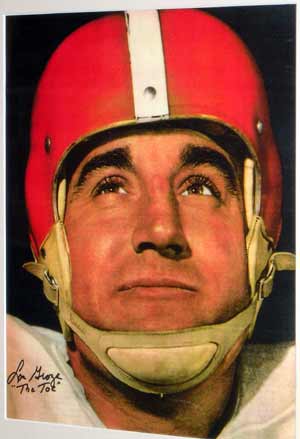 In Cleveland, we like our left tackles. It’s one small portion of our professional football tradition, a fun facet of our sports culture. That one position on the Browns’ roster has embodied excellence, tradition, and our blue-collar work ethic. Its history serves as a connection for us, to when our town dominated the sport.
In Cleveland, we like our left tackles. It’s one small portion of our professional football tradition, a fun facet of our sports culture. That one position on the Browns’ roster has embodied excellence, tradition, and our blue-collar work ethic. Its history serves as a connection for us, to when our town dominated the sport.
Lou Groza ‘48-‘59; Dick Schafrath ‘60-‘71; Doug Dieken ‘72-‘84
We like the fact that for so many years, the Browns’ legacy of excellence in protecting the quarterback’s “blind side” remained unbroken. But it’s more than that- 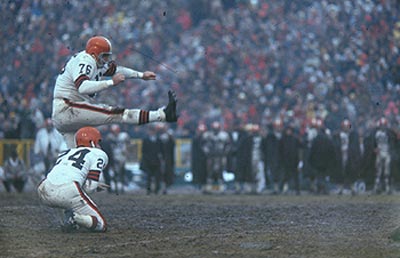 to varying degrees, each link in this chain embraced his lifelong membership in the Northeast Ohio family.
to varying degrees, each link in this chain embraced his lifelong membership in the Northeast Ohio family.
We point to when Lou Groza joined Paul Brown’s team in the post-WWII years. Sure, he’d become known as The Toe due to his high-profile kicking ability, but this Hall of Famer was instrumental in PBs preeminent pro offense. After a stellar career at left tackle, the Berea resident remained an ambassador for the team. Or, rather, for us fans: his outspoken criticism of Art Modell’s removal of the team from Cleveland in 1995 is summarized by this quote: he said the move was "like some man walking off with your wife."
Plenty of great Cleveland Browns players have graced the shores of Lake Erie. Their legacy is made more special when they are able to hand their position to another all-time great player. This was the case when Dick Schafrath joined the team as their left tackle, in 1960 (like Groza, he was an Ohio State alumnus). He blocked for Jim Brown, Bobby Mitchell and Leroy Kelly. Talk about work ethic- Schafrath’s nickname was “The Mule.” He had left college early, and bulked up with a then-innovative weight lifting regimen. He entered several Ohio eating contests, on the way to gaining fifty pounds in his first year with the 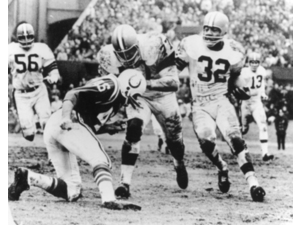 Browns. Throughout his life, Schafrath has been noted for various feats of endurance, such as running over 60 miles from Cleveland Browns Stadium to his hometown Wooster High School stadium, and canoeing across Lake Erie. His career as Ohio state senator spanned thirteen years. He also returned to complete his degree at Ohio State in 2006, at age 69.
Browns. Throughout his life, Schafrath has been noted for various feats of endurance, such as running over 60 miles from Cleveland Browns Stadium to his hometown Wooster High School stadium, and canoeing across Lake Erie. His career as Ohio state senator spanned thirteen years. He also returned to complete his degree at Ohio State in 2006, at age 69.
While Groza and Schafrath were highly-prized prospects when they turned pro, Doug Dieken was a 6th-round draft choice as a tight end from the University of Illinois’ run-dominated scheme. After a year as a backup, Dieken took over for Schafrath and assumed his own place in the pantheon of Cleveland Browns left tackles. Over a thirteen-year career with the Browns, he set team records for consecutive games started and games played. He famously made a key touchdown catch in a tackle-eligible play. But the life of the current Browns broadcaster is most defined by his love for the Browns and their fans. And humor.
A recurring joke has been Diek’s propensity to engage in offensive holding. As a player, his license plates read, 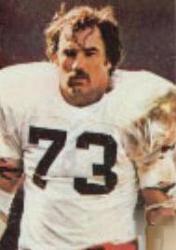 “MEHOLD.” When he retired, he had it changed to “MEHELD.”
“MEHOLD.” When he retired, he had it changed to “MEHELD.”
(I love this story I once read in a Cleveland Browns forum. According to the fan who wrote it, the Browns were playing an intra-squad scrimmage during training camp. It was open to the public, and they were using league referees. The offense was struggling. There was a holding call, and during the quiet few moments while the ref was walking off the penalty, one disgruntled fan hollered, clear as a bell: “IT’S DIEKEN. HE’S ALWAYS HOLDING.” Doug Dieken broke ranks, and sprinted to the sideline where the heckler sat. He took the can of beer the fan was holding, and chugged it dry. Dropping the can to the grass, Dieken stepped on it with his cleats, and using a line from a famous aftershave commercial, he said, “Thanks, I needed that!” With that, Dieken sprinted back and rejoined the huddle!)
Rickey Bolden, Paul Farren, and Tony Jones were left tackles for the Browns in the post- Doug Dieken era, with some success. But it says here that the true legacy of excellence at the position effectively ended in 1984. (Although one terrific memory of Bolden was when Browns’ kicker Matt Bahr was injured. The team had Bolden practicing field goal kicking on the sidelines. Nobody had any idea as to the direction of any particular kick- but he wowed the crowd with some truly awesome height and distance.)
Our Classic Rock tie-in this time - because 1) we’re Cleveland, and we like this stuff, and 2) we don’t need any other reasons- are songs that ‘go’ together. In honor of the succession of Browns players at a particular position, these will be tracks from the same album that are commonly played back-to-back. Or, at least if they are not, leaves listeners annoyed that they cannot hear the ‘follow-up’ song.
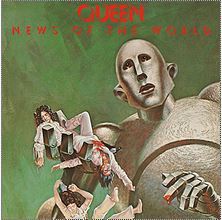
A public address staple at 21st Century sporting events, the anthem “We Will Rock You” is at least as popular now as it was when it was released 35 years ago. The two-minute tour de force can be considered as consisting of three parts: the first, as a heavily overdubbed stomp-stomp-clap rhythm, leading to Freddie Mercury’s a capella and ending with a deceptively simple Brian May lead guitar. The pregnant pause at the end leaves the listener suspended, ready to grab onto the opening bars of “We Are the Champions.” Unfortunately, that track is relatively anticlimactic. Very popular, however.
“Feeling That Way”, and “Anytime”, from the 1978 Journey album, Infinity.
Those who know me are smirking. Journey? Really? This album represented the band’s transition from a jazz fusion style to full-blown pop stardom. 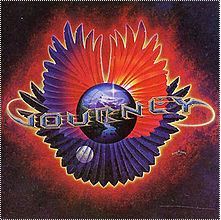
This was the album where lead singer Steve Perry joined the group. Keyboardist Greg Rolie, whom had come from the band Santana in 1973 with lead guitarist Neil Schon, had helped to form the precursor to what would become Journey. He shares vocals here with Perry. (Rolie had been the singer for Santana’s “Evil Ways” and “Black Magic Woman.”) From Infinity’s hits “Lights”, to “Wheel in the Sky”, this album works. At the conclusion of “Feeling That Way”, the listener is poised for the a capella harmony: “Oo-ooh any time that you want me.” (Silence.) “Oo-ooh any time that you need me.” The band crashes back in with a power-pop wallop. You cannot sing along and not smile.
Lou Groza ‘46-‘67; Don Cockroft ‘68-‘80; Matt Bahr ‘81-‘89; Jerry Kauric ‘90; Matt Stover ‘92-‘95
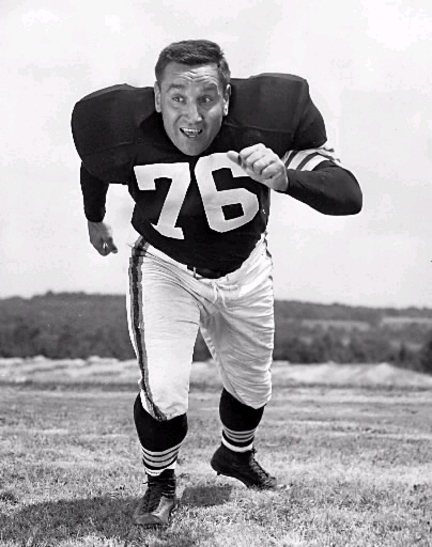 Lou “The Toe” starts the legacy for kickers of the Browns, as well. He kicked for a couple seasons prior to assuming the full-time role at left tackle, and for several seasons after his days on the offensive line were finished, as well. (There was one season in the middle there, when Groza temporarily retired due to an injured back.) Groza had the ability to kick then-unheard-of 50yd field goals, and his highest-profile moment in football was his game-winning kick in the 1950 NFL Championship Game.
Lou “The Toe” starts the legacy for kickers of the Browns, as well. He kicked for a couple seasons prior to assuming the full-time role at left tackle, and for several seasons after his days on the offensive line were finished, as well. (There was one season in the middle there, when Groza temporarily retired due to an injured back.) Groza had the ability to kick then-unheard-of 50yd field goals, and his highest-profile moment in football was his game-winning kick in the 1950 NFL Championship Game.
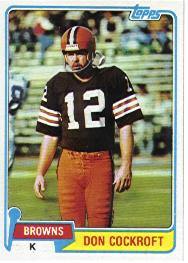 Don Cockroft, another adopted son of Browns fans, was the both the team’s kicker and punter for several seasons. He was one of the last of the breed of the straight-on toe kickers. Third in all-time points for the Browns behind Groza and Phil Dawson, Cockroft’s career spanned to the wild Kardiac Kids era of coach Sam Rutigliano and quarterback Brian Sipe (he wrote a book about that era.)
Don Cockroft, another adopted son of Browns fans, was the both the team’s kicker and punter for several seasons. He was one of the last of the breed of the straight-on toe kickers. Third in all-time points for the Browns behind Groza and Phil Dawson, Cockroft’s career spanned to the wild Kardiac Kids era of coach Sam Rutigliano and quarterback Brian Sipe (he wrote a book about that era.)
The Browns’ kicker during the 1980s was Matt Bahr. He had been a Penn State Nittany Lion, and followed his brother Chris into the NFL via the roster of the Pittsburgh Steelers. Bahr a dependable kicker through those ‘80s glory seasons, although he eventually became a victim to the injury bug as an unfortunately necessary (but capable) tackler on broken kickoff coverages.
Jerry Kauric only had the mythical “cup of coffee” with the Browns in 1990, but I decided to include him as a bridge to Matt Stover. Stover, who had hailed from the same Texas high school as Phil Dawson, was the promising kicker of the Bill Belichick era in Cleveland. Unfortunately, Browns fans had to watch their former kicker wearing Baltimore Ravens gear all the way through 2008.
 (My favorite memory of Stover was in 2007. What a crazy season, for the Browns- they’d lost the opener due to Dwayne Rudd removing his helmet before the final play was over. They ended up winning ten games- but just missed out on the playoffs. In a November game in Baltimore, the Browns’ Dawson lined up to kick a game-tying, 51yd field goal with time expiring. The ball apparently hit the goalpost, and richocheted back to the field. The referee signaled, “No Good.” The teams ran off the field (especially the Ravens) - but replays of the kick showed the ball first glancing off the left upright, then falling forward to the curved stanchion holding the crossbar, before falling backward back through the uprights and onto the field. It was a good kick. WOW. The refs held a five-minute discussion, and announced to the crowd they were continuing to look at the play. They ended up calling the kick “Good.” It is not clear if they used replay; according to the rules, field goals were not reviewable by replay.
(My favorite memory of Stover was in 2007. What a crazy season, for the Browns- they’d lost the opener due to Dwayne Rudd removing his helmet before the final play was over. They ended up winning ten games- but just missed out on the playoffs. In a November game in Baltimore, the Browns’ Dawson lined up to kick a game-tying, 51yd field goal with time expiring. The ball apparently hit the goalpost, and richocheted back to the field. The referee signaled, “No Good.” The teams ran off the field (especially the Ravens) - but replays of the kick showed the ball first glancing off the left upright, then falling forward to the curved stanchion holding the crossbar, before falling backward back through the uprights and onto the field. It was a good kick. WOW. The refs held a five-minute discussion, and announced to the crowd they were continuing to look at the play. They ended up calling the kick “Good.” It is not clear if they used replay; according to the rules, field goals were not reviewable by replay.
Where does Matt Stover come in with all of this? After the Dawson kick, Stover was being interviewed by a reporter near the field, and was discussing the ‘win’. Browns quarterback Derek Anderson walked up to Stover in mid-sentence, in the view of the TV camera, and said something to him to the effect of, “Hey, it’s not over, man!!” That was just hilarious, especially in the context of Dawson actually making that kick in that fashion. And the Browns would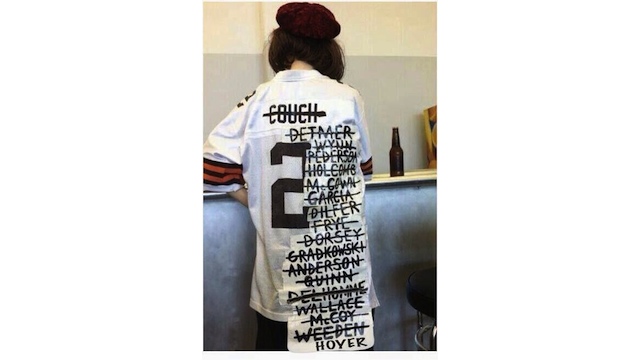 win it in overtime, on another Dawson kick.)
win it in overtime, on another Dawson kick.)
I know there are several other positions on the Browns that can boast of continuity of star-power through multiple eras. One position is at Center, with all-time Browns highlighting the lineage of Scarry/Gatski/Hunter/ Morrow/ Hoaglin/DeMarco/DeLeone/Baab from 1946 through 1987. Of course, every team’s fans can recite their quarterback legacy (although as we know, some recall it jokingly. Couch/Detmer/Wynn/Pederson/Holcomb/McCown/Garcia/Dilfer/Frye/Dorsey/Gradkowki/Anderson/Quinn/Delhomme/Wallace/McCoy/Weeden/Hoyer is not quite on the same level as Graham/O’Connell/Plum/Ryan/Nelsen/Phipps/Sipe/McDonald/Kosar/Tomzcak/Testaverde. And even the latter has some serious holes…)
But the last perpetuation of excellence we’ll review today is at feature back.
“Heartbeaker”, and “Living Loving Maid (She’s Just a Woman)”, from the 1969 Led Zeppelin album, Led Zeppelin II. (Click here, and then click to "Living Loving Maid" separately. Sorry, there's a mountain of covers out there and apparently not one good YouTube of the original, with both songs together.)
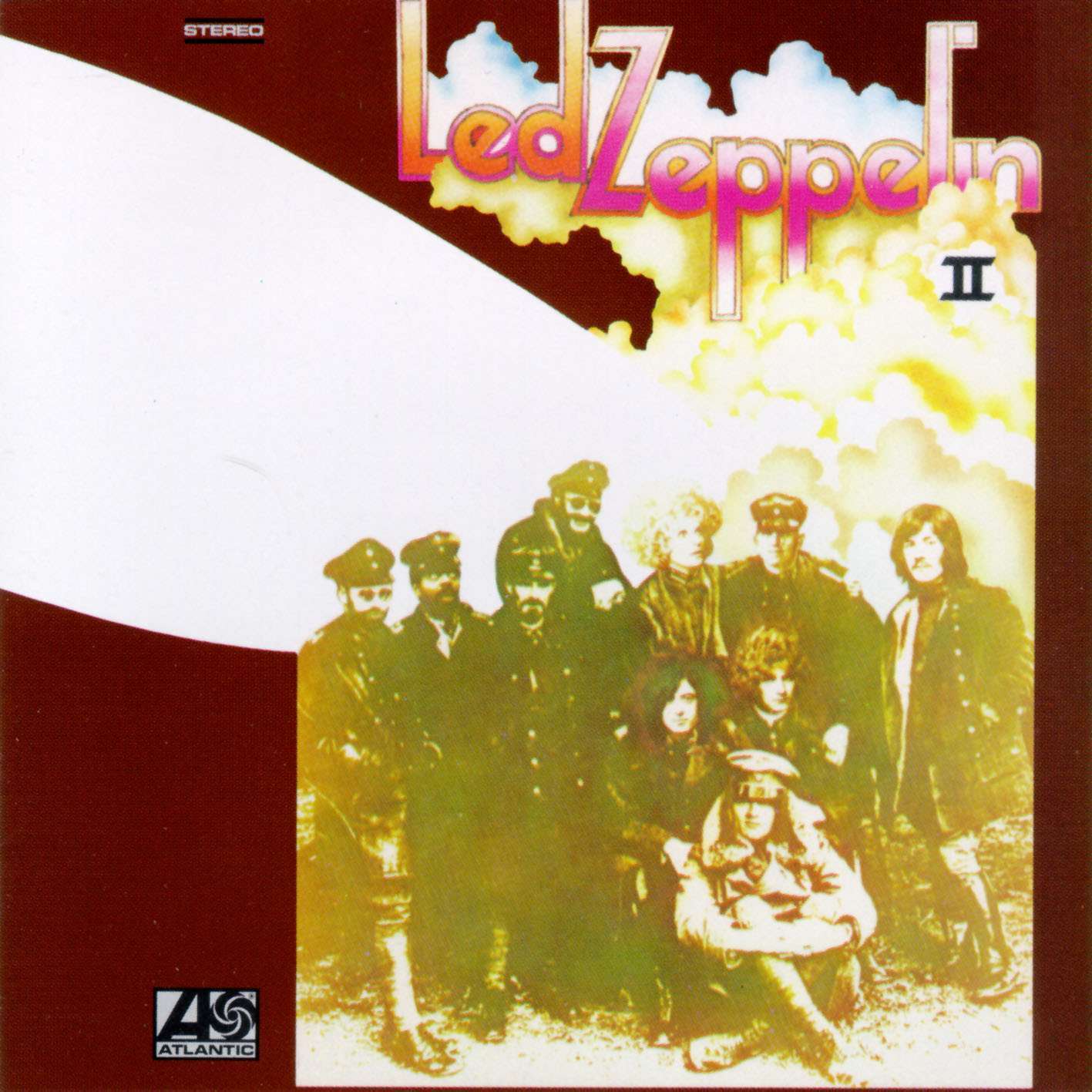 This album swapped the number one spot on the charts in ’69 with The Beatles’ Abbey Road. It is often cited as a blueprint for the heavy metal tendency to use a guitar riff where, in the past, a vocal chorus would be. Led Zeppelin II was the answer to a common question of the day: did Zeppelin have staying power? The band wrote and recorded II during the three tours that were done in support of their first album. Bassist John Paul Jones was quoted as noting many of the songs were sprung from Page’s improvised solos during performances of “Dazed and Confused.”
This album swapped the number one spot on the charts in ’69 with The Beatles’ Abbey Road. It is often cited as a blueprint for the heavy metal tendency to use a guitar riff where, in the past, a vocal chorus would be. Led Zeppelin II was the answer to a common question of the day: did Zeppelin have staying power? The band wrote and recorded II during the three tours that were done in support of their first album. Bassist John Paul Jones was quoted as noting many of the songs were sprung from Page’s improvised solos during performances of “Dazed and Confused.”
You know those lead guitarists who play solos just with their left hand for a while, on the neck of the guitar? Think Eddie Van Halen. Well, it was Jimmy Page who blazed that trail, on “Heartbreaker.” This track opens side two of the album, and moves right into “Living Loving Maid.” These two songs are always played together, on the radio. However, during the band’s live performances, they commonly played the former (sometimes in an encore), but almost never played the latter. It’s been said Page never liked “Maid” very much- although Robert Plant apparently does, as it has been featured in solo performances.
“Funeral For a Friend”, and “Love Lies Bleeding”, from the 1973 Elton John album, Goodbye Yellow Brick Road.
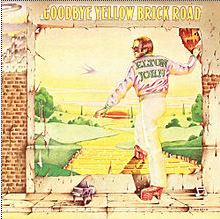
“Funeral for a Friend” opens side one. It is an instrumental that John says was not originally meant to blend into “Love Lies Bleeding”; they just fit together. Like Queen’s “We Are the Champions”, “Love Lies Bleeding” at first feels like a slight letdown. But it regains its stride, incorporating elements of “Funeral” before its eleven minutes are through.
Jim Brown ‘57-‘65; Leroy Kelly ‘66-‘73; Greg Pruitt ‘74-‘78
The ultimate Browns position legacy. Brown and Kelly are NFL Hall of Famers (Marion Motley is also in the Hall, but his run ended after 1952). 1970s Browns 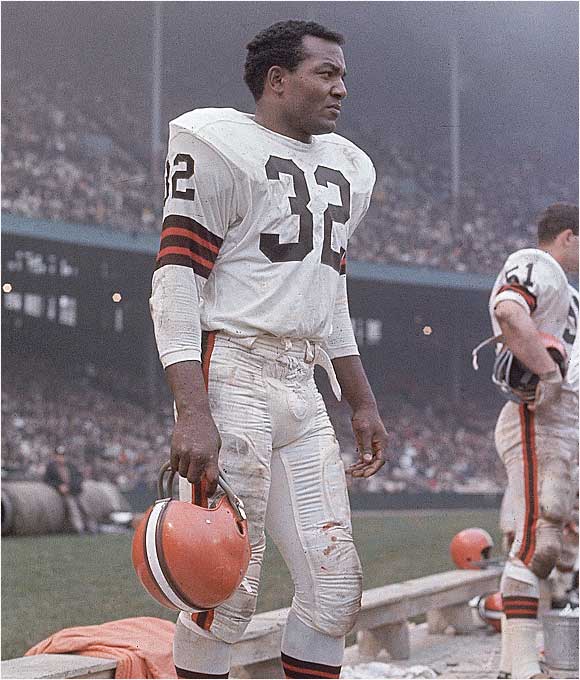 head coach Forrest Gregg once emphatically told me that Greg Pruitt belongs in the Hall of Fame as well- as an all-purpose back, returner and receiver.
head coach Forrest Gregg once emphatically told me that Greg Pruitt belongs in the Hall of Fame as well- as an all-purpose back, returner and receiver.
Jim Brown is one of those iconic players that I seldom attempt to address in an article. He’s like Bob Feller- to write a suitable bio would be to require a multi-installment piece. But then again, why bother- that story is readily available to readers, from multiple perspectives- including the player himself. In the context of our consideration today, JB is our anchor for feature back.
I say “feature back” because Brown was technically a fullback in Paul Brown’s offense. The halfback was essentially a blocking back. In his ten-year career, Brown set several season and career records on his way to becoming known as perhaps the best football player, ever- and one of the very greatest professional athletes of any sport, in history. There are chinks in the armor in his professional career (although he retired on his terms, his early departure left a lot of career production on the field). And more significantly, in his private life (eg. the troubling tales of domestic violence). But as a running back, Jim Brown is a pillar of the National Football League.
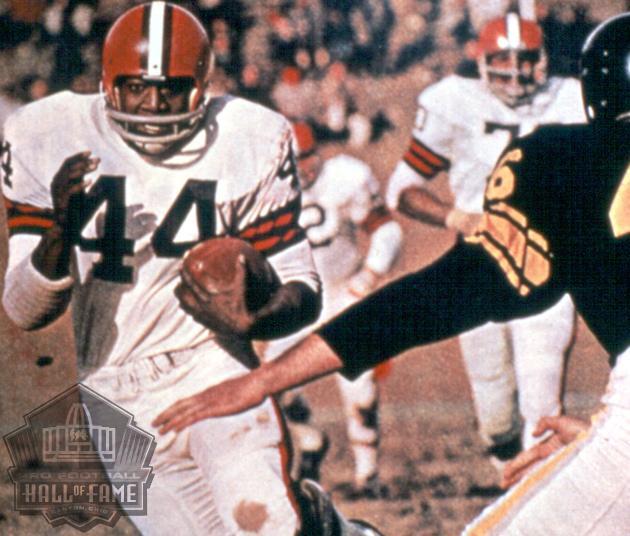 What a find for the Browns, in the eighth round of the 1964 NFL draft (albeit, in smaller league; he was pick number 110). All Leroy Kelly would do is immediately star as a return man, and develop into one of the best backs in the league. He racked up all-purpose yardage at a Hall-of-Fame pace. He was effective in the Browns’ famed trap play, yet could do serious damage on sweeps. As a receiver, as well. In an era of the NFL when grass fields didn’t drain as efficiently as they do today, Kelly was known, in horse racing terms, as a ‘mudder’. His flat-footed style enabled him to find traction in
What a find for the Browns, in the eighth round of the 1964 NFL draft (albeit, in smaller league; he was pick number 110). All Leroy Kelly would do is immediately star as a return man, and develop into one of the best backs in the league. He racked up all-purpose yardage at a Hall-of-Fame pace. He was effective in the Browns’ famed trap play, yet could do serious damage on sweeps. As a receiver, as well. In an era of the NFL when grass fields didn’t drain as efficiently as they do today, Kelly was known, in horse racing terms, as a ‘mudder’. His flat-footed style enabled him to find traction in 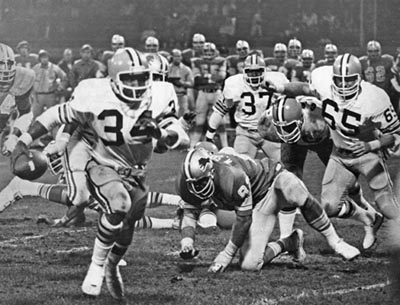 sloppy conditions, while defensive players struggled.
sloppy conditions, while defensive players struggled.
Greg Pruitt was not a ‘find’. He’d been a college star, a media darling, for coach Barry Switzer’s nationally prominent Oklahoma Sooners. Talk about an all-purpose back- Pruitt was effective as a halfback, but seemed ideally suited as an open-field runner. He was shifty as well as fast, and at one point with the Browns, he adopted the use of the ‘tear-away’ jersey. If a defensive player grabbed it, the jersey would simply rip loose and Pruitt would escape. The league banned the use of the ‘tear-away’ (in what became known as the “Greg Pruitt Rule”), but truth be told, he was about done with them anyway. They provided no warmth on frigid days at the Stadium. But even more problematic: since by rule, torn jerseys required a player to sit out at least one play and replace them, defenders simply took to ripping Pruitt’s jersey in between plays, to force him out of the game.
***Hey, follow me on Twitter! http://twitter.com/googleeph2 #thanks
Sources included football-reference.com; Wikipedia; clevelandseniors.com.
- NBA Announces 2013-2014 Schedule
- Browns Ink Sharknado
- Sharknado A No-Show For Rookie Camp
- Trent Richardson Out Until Training Camp
- Browns Sign Brandon Jackson
- Carrasco Suspended Eight Games
- Browns Add to Wide Receiver Depth with David Nelson
- Browns Need to Learn from Past Draft Mistakes
- Browns Release Chris Gocong and Usama Young
- Browns Missing on Grimes Disappointing, But Not The End
The TCF Forums
- Official- Browns Coach Search/Rumors
mattvan1 (Tuesday, January 21 2014 1:19 PM) - Movies coming out
rebelwithoutaclue (Tuesday, January 21 2014 12:56 PM) - 2015 Recruiting
jclvd_23 (Tuesday, January 21 2014 12:38 PM) - The 2014 Offseason Thread
Larvell Blanks (Tuesday, January 21 2014 12:25 PM) - Chris Grant's first 3 drafts
Kingpin74 (Tuesday, January 21 2014 10:13 AM) - Mike Brown
YahooFanChicago (Monday, January 20 2014 11:15 PM) - 2014 Hoops Hockey Hijinx
jpd1224 (Monday, January 20 2014 4:44 PM) - 2014 Recruiting
jclvd_23 (Monday, January 20 2014 2:26 PM) - Wish List - #4 Pick
Hikohadon (Monday, January 20 2014 1:26 PM) - #1 overall pick Anthony Bennett
TouchEmAllTime (Sunday, January 19 2014 1:28 PM)



